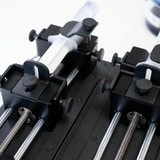Key Features of Ossila Syringe Pumps

A syringe pump is used in scientific research for precise and controlled delivery of fluids during experiments. They can be utilized for various applications in chemistry, biology, biochemistry, pharmaceuticals, and medical research. They can also be used with liquid chromatography systems, spectrophotometers, and automated sample processors.
Helping to deliver precise amounts of samples, reagents, or solvents to ensure accurate analysis and reproducible results. At Ossila, there are two available syringe pumps; the single syringe pump and the dual syringe pump. Both are programmable, accurate and have a wide range of flow rates.
Single Or Double Channel Syringe Pump?
The main difference between the Ossila syringe pumps is the number of syringe channels. Our single model has one syringe channel, whereas the dual model has two.
Dual Syringe Pump
Having dual-syringe channels provides flexibility in experimental setups, so you can use different syringes for different solutions. Each syringe can be controlled independently which allows solutions to be dispensed at varying rates. This means you can perform multiple tasks at the same time, saving time while increasing productivity.
A dual syringe can also be advantageous in calibration and validation, through referencing the delivery of one syringe against the other. This feature enhances accuracy and reliability in sophisticated analytical or dose-sensitive applications.
Single Syringe Pump
A singular syringe pump also offers several advantages in various applications:
- Their simplicity makes their set-up, control and maintenance easier.
- They also can be easily integrated with other equipment or systems, such as automated robotic systems, microfluidic set-ups, or analytical instruments.
- Their compatibility enables a seamless integration and coordination with other components or processes.
For experiments which require precise control and delivery of a single fluid, a singular syringe pump can enable the necessary precision and accuracy.
Programmability
The programmability of a syringe pump refers to the capacity of the pump to store and recall different programmed settings and sequences for fluid delivery.
Different experiments may require specific flow rates, volumes or timing sequences. By having multiple preprogrammes, you can easily switch between pre-set configurations, facilitating efficient and accurate fluid delivery for different specific experimental setups.
The stored programmes help ensure the reproducibility of experiments and reduces the likelihood of mistakes in your experiment. This feature is especially critical in research or analytical applications that require consistent and repeatable results.
At Ossila there are 10 available programmes to be had on the single and dual syringe pumps, all which can have 100 available steps.
Speed Control
The specification of speed on our syringe pumps refers to the rate at which the plunger of the syringe moves, thereby controlling the flow rate or dispensing rate of the fluid.
The minimum speed (12 µm.s-1) and the maximum speed (5 mm.s-1) is the same for all Ossila syringe pumps.
Many syringe pumps offer incremental speed control, allowing users to fine-tune the speed in small increments. This enables precise control over the flow rate for applications that require high accuracy or when dealing with sensitive fluids. Maximum and minimum flow rates for common syringe pump are as follows:
| Syringe Volume | Syringe Diameter | Minimum Flow Rate | Maximum Flow Rate |
|---|---|---|---|
| 0.5 µl | 0.103 mm | 0.6 pl.s-1 (2.1 nl.hr-1) | 42 nl.s-1 (0.15 ml.hr-1) |
| 10 µl | 0.46 mm | 12.5 pl.s-1 (45 nl.hr-1) | 0.8 µl.s-1 (3 ml.hr-1) |
| 100 µl | 1.46 mm | 0.1 nl.s-1 (0.36 µl.hr-1) | 8.4 µl.s-1 (29.8 ml.hr-1) |
| 1 ml | 4.61 mm | 1.3 nl.s-1 (4.7 µl.hr-1) | 84 µl.s-1 (298 ml.hr-1) |
| 5 ml | 10.3 mm | 6.3 nl.s-1 (22.7 µl.hr-1) | 0.4 ml.s-1 (1.5 l.hr-1) |
| 50 ml | 32.6 mm | 62.6 nl.s-1 (225 µl.hr-1) | 4.2 ml.s-1 (15 l.hr-1) |
Rate Accuracy
The rate accuracy of a syringe pump refers to how closely the actual flow rate achieved by the pump matches the desired or set flow rate.
It is typically expressed as a percentage or error and depends on various factors, including the pump’s design, calibration, and the specific fluid being delivered.
Accurate calibration of the syringe pump is crucial in determining its rate accuracy. Regular calibration ensures that the pump is delivering fluids at the intended flow rate.
The rate accuracy can also be influenced by the type of syringe which is used. For example, the material and construction of the syringe can play a role in rate accuracy. High-quality syringes made from materials with low friction and excellent dimensional stability can provide better accuracy compared to syringes with lower-quality construction or materials that introduce additional friction or variability. For example, stainless steel syringes are durable, robust, and resistant to corrosion. They are well-suited for applications requiring high pressures, high force dispensing, or when working with viscous fluids.
The rate accuracy is ±3% for Ossila syringe pumps (for both the single and dual syringe pump).
Syringe Pump

Further Resources
 Syringe Pump Accuracy and Precision
Syringe Pump Accuracy and Precision
A syringe pump provides precise control over the movement and delivery of fluids and can be incorporated into a wide range of experimental setups, ensuring that any work done is reproducible and accurate. Although syringe pumps can offer extremely fine control over the movement of the syringe, there are limitations associated with any measurement system. It is well known that the accuracy and precision of your measurement system is as good as your least accurate element. Therefore, it is important that you understand potential sources of error associated with syringe pumps.
Read more... How to Set Up: Continuous Flow with Dual Syringe Pump
How to Set Up: Continuous Flow with Dual Syringe Pump
Continuous syringe pumping is an effective way to dispense a uniform flow of solution over a long time period. This is essential for a wide range of applications. Some example applications of continual syringe pumping include...
Read more...